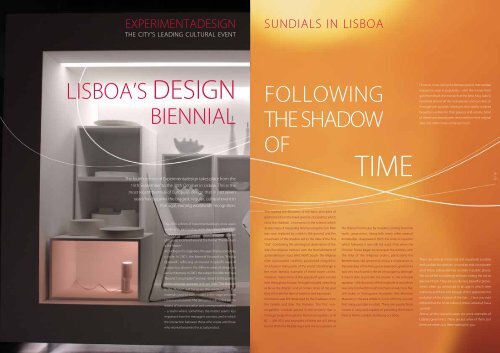lisboa city lisboa city
lisboa city lisboa city
lisboa city lisboa city
Create successful ePaper yourself
Turn your PDF publications into a flip-book with our unique Google optimized e-Paper software.
EXPERIMENTADESIGN<br />
THE CITY’S LEADING CULTURAL EVENT<br />
LISBOA’S DESIGN<br />
BIENNIAL<br />
The fourth edition of Experimentadesign takes place from the<br />
15th September to the 30th October in Lisboa. This is the<br />
most recent biennial of European design that in just seven<br />
years has become the biggest, regular, cultural event in<br />
Portugal, earning worldwide recognition.<br />
The 2005 edition of Experimentadesign, once again<br />
working in partnership with the Lisboa Municipal<br />
Council and with the support of the Portuguese Ministry<br />
of Culture, is centred around the theme “The Medium<br />
is the Matter”.<br />
According to the organisers, this year’s theme completes<br />
a cycle. In 2001, the biennial focused on “Modus<br />
Operandi”, reflecting an interest in specific ways of<br />
producing culture in the different areas of design, art<br />
and architecture. In 2003, the subject for reflection was<br />
“Beyond Consumption” and was related to the position<br />
of the consumer, spectator and user. Now, “The Medium<br />
is the Matter” will focus on the medium and the<br />
materials used for transmission in the stage between<br />
creator and receiver. The discussion will centre on the<br />
means of communication and communicative objects<br />
– a realm where sometimes the matter seems less<br />
important than the message it conveys, and in which<br />
the interaction between those who create and those<br />
who receive becomes the actual product.<br />
SUNDIALS IN LISBOA<br />
FOLLOWING<br />
THE SHADOW<br />
OF<br />
This marked the discovery of the basic principles of<br />
gnomonics (from the Greek gnomon, the pointer, which<br />
casts the shadow). Gnomonics is the science which<br />
studies ways of measuring time by using the Sun. Man<br />
was soon replaced by a stick in the ground, and the<br />
movement of the shadow led to the idea of the first<br />
“dial”. Combining the astrological observation of the<br />
skies (for religious motives) with the first rudiments of<br />
spatial direction – East, West, North, South - the religious<br />
elite constructed carefully positioned megalithic<br />
structures in many parts of the world. Stonehenge is<br />
the most famous example of these stone circles.<br />
However, many more of this species of giant sundial<br />
exist throughout Europe, Portugal included, stretching<br />
as far as the Atlantic, and at certain times of the year<br />
they still mark the time of solstices and equinoxes.<br />
Gnomonics was first developed by the Chaldeans, then<br />
the Greeks and later the Romans. The first nonmegalithic<br />
sundials arrived in the territory that is<br />
Portugal today through the Roman occupation (218<br />
BC. – 409 AD.) and examples of these are still being<br />
found. With the Middle Ages and the occupation of<br />
TIME<br />
the Iberian Peninsular by invaders coming from the<br />
north, gnomonics , along with many other areas of<br />
knowledge, disappeared. With the Arab occupation<br />
which followed, it was still not used. Only when the<br />
Christian forces began to reconquer the territory, with<br />
the help of the religious orders, particularly the<br />
Benedictines, did gnomonics enjoy a renaissance. In<br />
the early days of the Portuguese expansion, gnomonics<br />
was very much used in the art of navigating, although<br />
it wasn’t able to provide the answer to the principle<br />
question – the discovery of the longitude at sea (which<br />
was only resolved through mechanical watches). But,<br />
still today, in Portuguese museums (the Maritime<br />
Museum, in the area of Belém, is one of them), one can<br />
find many portable sundials. These are usually finely<br />
carved in ivory and capable of providing the time in<br />
Paris or Rome, London, Hamburg or Lisboa.<br />
However, it was during the Baroque period, that sundials<br />
enjoyed a surge in popularity – with the money from<br />
gold from Brazil, the monarch at the time, King João V,<br />
furnished almost all the monasteries and convents in<br />
Portugal with sundials. Moreover, the nobility ordered<br />
beautiful sundials for their palaces and estates. Most<br />
of these have already been removed from their original<br />
sites, but others have remained in tact.<br />
There are vertical, horizontal and equatorial sundials<br />
and sundials for solstices, or sundials that incorporate<br />
all of these. Lisboa also has sundials in public places.<br />
We would like to challenge all those visiting the <strong>city</strong> to<br />
discover them. They are usually very beautiful pieces,<br />
which often go unnoticed in an age in which time<br />
rushes by and there isn’t enough of it to appreciate the<br />
evolution of the shadow of the Sun… Have you ever<br />
noticed that the Sé de Lisboa (Lisboa Cathedral) has a<br />
sundial?<br />
Above, on the opposite page, are some examples of<br />
Lisboa’s gnomonics. These are just a few of them, but<br />
there are others out there waiting for you.<br />
28 _<br />
29


